Miele PW 6065 Sluice Operating instructions
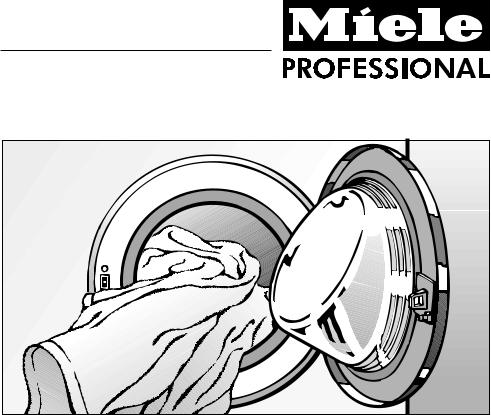
Operating and installation instructions for washer-extractor
PW 6065 Sluice
To avoid the risk of accidents or |
en - GB |
|
|
damage to the machine it is |
|
essential to read these instructions |
|
before it is installed and used for the |
|
first time. |
M.-Nr. 07 017 110 |
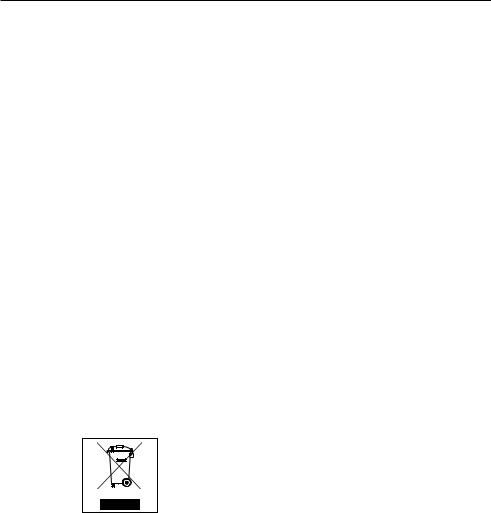
Caring for the environment
Disposing of the packing material
The transport and protective packing has been selected from materials which are environmentally friendly for disposal and can normally be recycled.
Ensure that any plastic wrappings, bags, etc. are disposed of safely and kept out of the reach of babies and young children. Danger of suffocation.
Rather than just throwing these materials away, please ensure that they are offered for recycling.
Disposal of your old machine
Electrical and electronic machines often contain materials which, if handled or disposed of incorrectly, could be potentially hazardous to human health and to the environment. They are, however, essential for the correct functioning of your machine. Please do not therefore dispose or it with your household waste.
Please dispose of it at your local community waste collection/recycling centre, and ensure that it presents no danger to children while being stored for disposal.
It should be unplugged or disconnected from the mains electricity supply by a competent person.
Energy saving tips
Energy and water consumption
–Water consumption and energy usage are determined by the size of the load.
To make the most out of your machine load the maximum dry load for the programme you are using.
–If smaller loads are washed using the
Cottons programmes, the automatic load recognition system will reduce the amount of water, time and energy used.
Detergent
–Do not exceed the amounts of detergent recommended by the manufacturer on the packaging.
–Reduce the amount of detergent for smaller loads.
2

Contents
Caring for the environment . . . . . . . . . . . . . . . . . . . . . . . . . . . . . . . . . . . . . . . . . . 2
Disposing of the packing material . . . . . . . . . . . . . . . . . . . . . . . . . . . . . . . . . . . . . . 2 Disposal of your old machine . . . . . . . . . . . . . . . . . . . . . . . . . . . . . . . . . . . . . . . . . 2 Energy saving tips . . . . . . . . . . . . . . . . . . . . . . . . . . . . . . . . . . . . . . . . . . . . . . . . . . 2
Warning and Safety instructions . . . . . . . . . . . . . . . . . . . . . . . . . . . . . . . . . . . . . 6
Operating the washer-extractor . . . . . . . . . . . . . . . . . . . . . . . . . . . . . . . . . . . . . 10
Control panel . . . . . . . . . . . . . . . . . . . . . . . . . . . . . . . . . . . . . . . . . . . . . . . . . . . . . 10 Displays . . . . . . . . . . . . . . . . . . . . . . . . . . . . . . . . . . . . . . . . . . . . . . . . . . . . . . . . . 11
Before using for the first time. . . . . . . . . . . . . . . . . . . . . . . . . . . . . . . . . . . . . . . 13
How to wash correctly. . . . . . . . . . . . . . . . . . . . . . . . . . . . . . . . . . . . . . . . . . . . . 15
Brief instructions . . . . . . . . . . . . . . . . . . . . . . . . . . . . . . . . . . . . . . . . . . . . . . . . . . 15
Spinning . . . . . . . . . . . . . . . . . . . . . . . . . . . . . . . . . . . . . . . . . . . . . . . . . . . . . . . . 19
Final spin speed . . . . . . . . . . . . . . . . . . . . . . . . . . . . . . . . . . . . . . . . . . . . . . . . . . 19 Rinse and interim spin . . . . . . . . . . . . . . . . . . . . . . . . . . . . . . . . . . . . . . . . . . . 19
Programme chart . . . . . . . . . . . . . . . . . . . . . . . . . . . . . . . . . . . . . . . . . . . . . . . . . 20
Programme sequence . . . . . . . . . . . . . . . . . . . . . . . . . . . . . . . . . . . . . . . . . . . . . 24
Garment care label symbols . . . . . . . . . . . . . . . . . . . . . . . . . . . . . . . . . . . . . . . . 26
Changing the programme sequence . . . . . . . . . . . . . . . . . . . . . . . . . . . . . . . . . 27
Altering a programme . . . . . . . . . . . . . . . . . . . . . . . . . . . . . . . . . . . . . . . . . . . . . . 27 Cancelling a programme . . . . . . . . . . . . . . . . . . . . . . . . . . . . . . . . . . . . . . . . . . . . 27 Adding or removing laundry after a programme has started . . . . . . . . . . . . . . . . 27
Detergent . . . . . . . . . . . . . . . . . . . . . . . . . . . . . . . . . . . . . . . . . . . . . . . . . . . . . . . 28
Water softeners . . . . . . . . . . . . . . . . . . . . . . . . . . . . . . . . . . . . . . . . . . . . . . . . . . . 29 Washing with several components . . . . . . . . . . . . . . . . . . . . . . . . . . . . . . . . . . . . 29 External dispensing system . . . . . . . . . . . . . . . . . . . . . . . . . . . . . . . . . . . . . . . 29
3

Contents
Fabric conditioners and liquid starch . . . . . . . . . . . . . . . . . . . . . . . . . . . . . . . . . . 30 Automatic dispensing of fabric conditioner or liquid starch to laundry
at the end of a programme . . . . . . . . . . . . . . . . . . . . . . . . . . . . . . . . . . . . . . . . 30 Colour run and dye removers / dyes . . . . . . . . . . . . . . . . . . . . . . . . . . . . . . . . 30
Cleaning and care . . . . . . . . . . . . . . . . . . . . . . . . . . . . . . . . . . . . . . . . . . . . . . . . 31
Cleaning the water inlet filters . . . . . . . . . . . . . . . . . . . . . . . . . . . . . . . . . . . . . . . . 33
Problem solving guide . . . . . . . . . . . . . . . . . . . . . . . . . . . . . . . . . . . . . . . . . . . . 34
What to do, if . . . . . . . . . . . . . . . . . . . . . . . . . . . . . . . . . . . . . . . . . . . . . . . . . . . . . 34 The programme does not start . . . . . . . . . . . . . . . . . . . . . . . . . . . . . . . . . . . . . . . 34 General problems . . . . . . . . . . . . . . . . . . . . . . . . . . . . . . . . . . . . . . . . . . . . . . . . . 35 An unsatisfactory wash result . . . . . . . . . . . . . . . . . . . . . . . . . . . . . . . . . . . . . . . . 36 The drum door cannot be opened by pressing the a button . . . . . . . . . . . . . . . 37 Opening the drum door in the event of a blocked drain outlet and/or
power failure . . . . . . . . . . . . . . . . . . . . . . . . . . . . . . . . . . . . . . . . . . . . . . . . . . . . . 38
After sales service . . . . . . . . . . . . . . . . . . . . . . . . . . . . . . . . . . . . . . . . . . . . . . . . 41
PC / Optical interface. . . . . . . . . . . . . . . . . . . . . . . . . . . . . . . . . . . . . . . . . . . . . . . 41 Optional accessories . . . . . . . . . . . . . . . . . . . . . . . . . . . . . . . . . . . . . . . . . . . . . . . 41
Installation and connection . . . . . . . . . . . . . . . . . . . . . . . . . . . . . . . . . . . . . . . . 42
Front view. . . . . . . . . . . . . . . . . . . . . . . . . . . . . . . . . . . . . . . . . . . . . . . . . . . . . . . . 42 Rear view . . . . . . . . . . . . . . . . . . . . . . . . . . . . . . . . . . . . . . . . . . . . . . . . . . . . . . . . 43 Installation on a raised plinth . . . . . . . . . . . . . . . . . . . . . . . . . . . . . . . . . . . . . . . . . 44 Washer-dryer stack . . . . . . . . . . . . . . . . . . . . . . . . . . . . . . . . . . . . . . . . . . . . . . . . 44 Payment system. . . . . . . . . . . . . . . . . . . . . . . . . . . . . . . . . . . . . . . . . . . . . . . . . . . 44 Installation surface. . . . . . . . . . . . . . . . . . . . . . . . . . . . . . . . . . . . . . . . . . . . . . . . . 45 Installing the washer-extractor. . . . . . . . . . . . . . . . . . . . . . . . . . . . . . . . . . . . . . . . 45 Removing the transit struts . . . . . . . . . . . . . . . . . . . . . . . . . . . . . . . . . . . . . . . . . . 45 Re-fitting the transit struts . . . . . . . . . . . . . . . . . . . . . . . . . . . . . . . . . . . . . . . . . . . 47 Levelling the machine . . . . . . . . . . . . . . . . . . . . . . . . . . . . . . . . . . . . . . . . . . . . . . 48 Plumbing . . . . . . . . . . . . . . . . . . . . . . . . . . . . . . . . . . . . . . . . . . . . . . . . . . . . . . . . 49
Connection to the cold water supply . . . . . . . . . . . . . . . . . . . . . . . . . . . . . . . . 49 Connection to the hot water supply . . . . . . . . . . . . . . . . . . . . . . . . . . . . . . . . . 50
4

Contents
Connection to drainage . . . . . . . . . . . . . . . . . . . . . . . . . . . . . . . . . . . . . . . . . . . . . 51 Machines with a drain pump . . . . . . . . . . . . . . . . . . . . . . . . . . . . . . . . . . . . . . 51 Dump valve version . . . . . . . . . . . . . . . . . . . . . . . . . . . . . . . . . . . . . . . . . . . . . 51 Electrical connection U.K. . . . . . . . . . . . . . . . . . . . . . . . . . . . . . . . . . . . . . . . . . . . 52
Technical data . . . . . . . . . . . . . . . . . . . . . . . . . . . . . . . . . . . . . . . . . . . . . . . . . . . 53
Changing default settings . . . . . . . . . . . . . . . . . . . . . . . . . . . . . . . . . . . . . . . . . . 54
Settings menu J. . . . . . . . . . . . . . . . . . . . . . . . . . . . . . . . . . . . . . . . . . . . . . . . . . 55
To open the Settings menu . . . . . . . . . . . . . . . . . . . . . . . . . . . . . . . . . . . . . . . . . . 55 Language J. . . . . . . . . . . . . . . . . . . . . . . . . . . . . . . . . . . . . . . . . . . . . . . . . . . . . . 56 Suds cooling . . . . . . . . . . . . . . . . . . . . . . . . . . . . . . . . . . . . . . . . . . . . . . . . . . . . . 56 Display contrast / Brightness . . . . . . . . . . . . . . . . . . . . . . . . . . . . . . . . . . . . . . . . . 57 Standby . . . . . . . . . . . . . . . . . . . . . . . . . . . . . . . . . . . . . . . . . . . . . . . . . . . . . . . . . 57 Memory . . . . . . . . . . . . . . . . . . . . . . . . . . . . . . . . . . . . . . . . . . . . . . . . . . . . . . . . . 57 Temperature unit . . . . . . . . . . . . . . . . . . . . . . . . . . . . . . . . . . . . . . . . . . . . . . . . . . 57
Settings/Supervisor level menu . . . . . . . . . . . . . . . . . . . . . . . . . . . . . . . . . . . . . 58
5

Warning and Safety instructions
This machine conforms to current safety requirements. Inappropriate use can, however, lead to personal injury and damage to property.
To avoid the risk of accidents and damage to the machine, please read these instructions carefully before using it for the first time. They contain important information on its safety, use and maintenance.
Keep these instructions in a safe place and ensure that new users are familiar with the content. Pass them on to any future owner.
Correct application
Only use the machine to wash items which are specified by the
manufacturer to be machine-washable on the wash-care label, and textiles composed of hand-washable wool or wool blend fabrics as well as satin, lace, silk and other hand-washable garments. Any other applications may be dangerous. The manufacturer cannot be held liable for damage resulting from incorrect or improper use or operation.
This machine must be used as described in these operating instructions and must be checked on a
regular basis to make sure it is functioning correctly. Maintenance must be carried out when necessary.
This machine is not intended for use by persons (including children)
with reduced physical, sensory or mental capabilities, or lack of experience and knowldege, unless they have been given supervision or instruction concerning its use by a person responsible for their safety.
Safety with children
Keep children away from the machine at all times. It is not a toy!
To avoid the risk of injury do not allow children to play on or near it or to play with its controls. Supervise its use by the elderly or infirm, and supervise children whilst you are using it.
Older children may only use the machine if its operation has been
clearly explained to them and they are able to use it safely, recognising the dangers of misuse.
For machines with a 'porthole' door, remember that the porthole
glass will be hot when washing at very high temperatures
Do not let children touch it.
6

Warning and Safety instructions
Technical safety
Before setting up the washing machine, check it for any externally
visible damage.
Do not install or use a damaged machine.
Before connecting the machine, ensure that the connection data on
the data plate (voltage and connected load) match the mains electricity supply. If in any doubt, consult a qualified electrician.
The electrical safety of this machine can only be guaranteed
when continuity is complete between the machine and an effective earthing system which complies with current local and national safety regulations. It is most important that this basic safety requirement is present and regularly tested, and where there is any doubt the household wiring system should be inspected by a qualified electrician. The manufacturer cannot be held liable for the consequences of an inadequate earthing system (e.g. electric shock).
Do not connect the machine to the mains electricity supply by an
extension lead. Extension leads do not guarantee the required safety of the machine (e.g. danger of overheating).
Unauthorised repairs could result in unforeseen dangers for the user,
for which the manufacturer cannot accept liability. Repairs should only be undertaken by a Miele approved service technician.
Ensure current is not supplied to the machine until after maintenance or repair work has been carried out.
In the event of a fault or for cleaning purposes, the machine is
only completely isolated from the electricity supply when:
–it is switched off at the wall socket and the plug is withdrawn, or
–it is switched off at the mains, or
–the mains fuse has been withdrawn, or the screw-out fuse removed (in countries where this is applicable).
This machine must only be connected to the on-site water
supply using a new hose kit. Old hoses must not be re-used. Check the hose regularly for signs of wear. Change in good time to avoid the risk of leaks and subsequent damage.
Faulty components must only be replaced by genuine Miele original
spare parts. Only when these parts are fitted can the safety standards of the machine be guaranteed.
If the connection cable is faulty it must only be replaced by a Miele approved service technician to protect
the user from danger.
In countries where there are areas which may be subject to infestation
by cockroaches or other vermin, pay particular attention to keeping the machine and its surroundings in a clean condition at all times. Any damage caused by cockroaches or other vermin will not be covered by the machine guarantee.
7

Warning and Safety instructions
If this machine is being used in a commercial environment please
ensure that all relevant health and safety regulations are obeyed.
This machine may only be used in mobile installations such as ships if
a risk assessment of the installation has been carried out by a suitably qualified engineer.
Correct application
Do not install your machine in rooms where temperatures below
freezing may occur. Frozen hoses may burst or split. The reliability of the electronic control unit may be impaired at temperatures below freezing point.
Before using the machine for the first time, check that the transit
bars at the rear of the machine have been removed (see section on "Installation"). During spinning, a transit bar which is still in place may result in damage to both the machine and adjacent furniture or appliances.
Turn off the stopcock if the machine is to be left for any length
of time (e.g. holiday), especially if there is no floor drain (gully) in the immediate vicinity.
Flooding danger.
If hooking the drain hose into a wash basin, check that the water can drain off quickly enough to prevent the sink from overflowing. Make sure the drain hose is secure, so that the force of the water flowing out of the hose does not dislodge it.
Take care to ensure that foreign objects (e.g. nails, pins, coins,
paper clips) do not find their way into the machine with the laundry. These may damage components of the machine (e.g. suds container, drum), which in turn can result in damage to the laundry.
If the correct amount of detergent is dispensed, the machine should not need to be descaled. If, however,
you do wish to descale the machine only use proprietary non-corrosive descaling agents and strictly observe the instructions on the packaging. A special descaling agent is available to order from your Miele Dealer or the Miele Spare Parts Department.
8

Warning and Safety instructions
Textiles which have been pre-treated in solvent based
cleaning agents must be thoroughly rinsed in clean water before being washed in the machine.
Never use solvent based cleaning agents in this machine, as this may
result in damage to component parts and create toxic fumes. Such agents also pose a fire and explosion hazard.
Only use dyes specified by the manufacturer as being suitable for
use in a washing machine. Always observe the manufacturer's instructions carefully.
Colour run and dye removers contain sulphur compounds which
can cause damage such as corrosion. Do not use these products in this machine.
Avoid contact of stainless steel surfaces (front, lid, casing) with
liquid cleaning and disinfecting agents which contain chlorine or sodium hypochlorite. These agents can have a corrosive effect on stainless steel. Aggressive vapours containing chlorine bleach can also be corrosive. Do not store open containers of these agents near the machine.
Accessories
Accessory parts may only be fitted when expressly approved by
Miele. If other parts are used, guarantee, performance and product liability claims will be invalidated.
Miele cannot be held liable for damage caused by non-compliance with these Warning and Safety instructions.
9
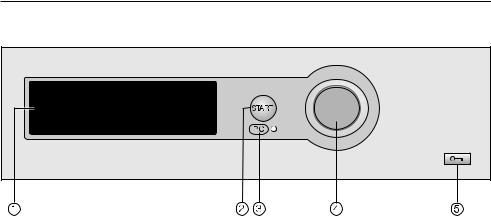
Operating the washer-extractor
Control panel
aDisplay
See the following pages for more information.
b Start button
cPC / Optical interface
This is used by service technicians to run diagnostic checks on your machine and can also be used to update programming data in the future.
dMulti-function selector
This is used to select menu options (by turning it) and to confirm your selection (by pressing it).
ea button
Opens the machine door.
10
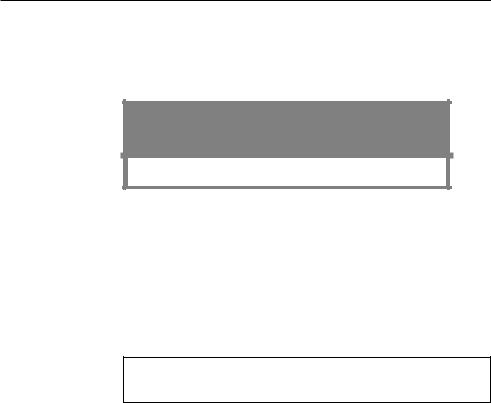
Operating the washer-extractor
Displays
Entry menu
The machine is on standby if the display remains dark when you switch the machine on. Press the multi-function selector.
Welcome
Please select
|
|
Language F |
|
...Programme selection |
|
|
|
|
|
|
|
The entry menu will appear with Programme selection highlighted. Press the multi-function selector. The Programme selection menu will appear.
Programme selection menu
|
Sluice High |
75°C |
Delicates |
40°C |
|
|
|
|
|
Sluice Low |
65°C |
Cottons Hygiene |
95°C |
|
Cottons Uni. |
60°C |
Minimum iron |
40°C |
|
Cottons Uni. |
40°C |
Woollens / |
30°C H |
|
|
|
|
|
|
If you do not make a selection within approx. 20 seconds, the display will revert to the main menu.
Multi-function selector
Turning the multi-function selector moves the highlighting to the next option.
Pressing the multi-function selector selects the highlighted option.
You can use the multi-function selector to select any programme. The highlighting will move up or down depending on the direction the multi-function selector is turned in. The HVarrows on the right of the display, indicate further options. Pressing the multi-function selector takes you to the main menu of the wash programme selected.
11

Operating the washer-extractor
Wash programme main menu
Cottons Uni. |
60°C |
1400 rpm |
|||
Duration 0:45 h |
|
|
|
||
|
|
|
|
|
|
|
|
|
Back A |
|
|
|
Pre-wash |
|
|
|
|
|
|
|
|
|
|
The main menu shows the temperature and spin speed for the wash programme selected. The Pre-wash extra option is highlighted. Press the multi-function selector to deselect / select Pre-wash.
To return to the Programme selection menu turn the multi-function selector to highlight Back and then press the multi-function selector to confirm your selection.
Settings menu
The Settings menu is used to alter the washing machine's electronics to suit different requirements. See "Settings menu" for more details.
12

Before using for the first time
Before using the machine for the first time ensure that it is correctly installed and connected. See "Installation and connection". Also check that the drain filter is securely tightened to prevent the risk of water leaks during use.
For safety reasons spinning is not possible until the machine has been prepared for using for the first time. To activate the spinning function you must run a wash programme without laundry and without detergent.
^ Open the stopcocks.
Welcome screen
When the washer-extractor is switched on for the first time, a welcome screen will appear.
Miele Professional Welcome.
The welcome screen will not appear again after the first programme has been completed.
After four seconds the display will change to the screen for setting the language.
Language J
^ Select the language you want and confirm your selection.
Reminder to remove transport struts
The machine will remind you to remove the transport struts.
^Remove the transport struts (if this has not already been done by your fitter). Then press the multi-function selector to confirm that this has been done.
13
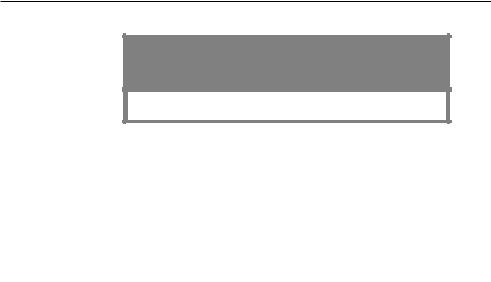
Before using for the first time
Running your first programme
Welcome
Please select
|
|
Language F |
|
...Programme selection |
|
|
|
|
^Turn the multi-function selector until Programme selection is highlighted and then press the multi-function selector to confirm your selection.
^Select Cottons Uni. 60°C and confirm your selection.
The main menu for Cottons Uni. will appear.
Cottons Uni. |
60°C |
1400 rpm |
|||
Duration 0:47 h |
|
|
|
||
|
|
|
|
|
|
|
|
|
Back A |
|
|
|
Pre-wash |
|
|
|
|
|
|
|
|
|
|
|
|
|
|
|
|
^Press the flashing Start button (the machine door must be closed).
When this programme has finished, your machine is ready for using for the first time.
14
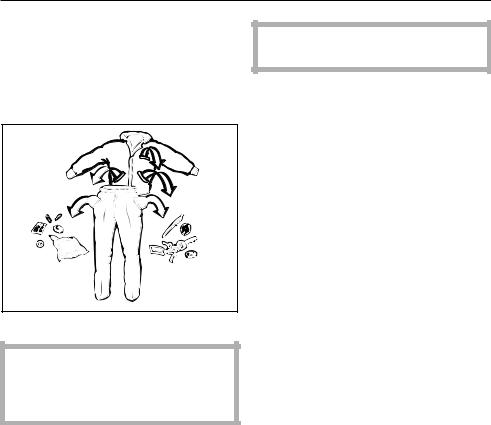
How to wash correctly
Brief instructions
The headings numbered A, B, C, . . .
show the operating sequence and can be used as brief instructions.
A Sort the laundry
^ Empty all pockets.
,Foreign objects (e.g. nails, coins, paper clips, etc.) can cause damage to garments and components in the machine.
Removing marks
^Badly soiled areas, stains etc. should be removed as soon as possible, preferably whilst still fresh. Spillages should be carefully dabbed off using a soft colourfast cloth. Do not rub!
Badly soiled areas can be pre-treated with liquid detergent, stain removers etc. first, following the manufacturer's instructions. With particularly stubborn stains ask your dry cleaner for advice.
,Do not use solvent-based cleaning agents in this machine.
^Sort the laundry by colour and by care label. Most garments have a textile care label in the collar or side seam.
Dark textiles often contain excess dye and should be washed separately several times before being included in a mixed load. Always wash whites and coloureds separately.
–Curtains: Remove lead weights first or place in a laundry bag.
–Underwiring and collar stiffeners: Any loose wiring in bras, shirt collar stiffeners, etc. should be removed or sewn in.
–Knitted garments, trousers and jeans, T-shirts and sweat shirts: Turn inside out, if recommended by the manufacturer.
–Close any zips, fasten hooks and eyes etc before washing.
–Fasten duvet covers etc. to prevent small items from being rolled up inside them.
Do not wash any items in this machine which are specified by the manufacturer as not washable on the care label (h symbol).
15

How to wash correctly
B Load the drum
^Press the a button and open the drum door.
The interior drum lighting will come on.
^Unfold the laundry and load loosely in the drum. Mixing both large and small items gives better wash results and also helps distribute the load evenly during spinning.
The most efficient use of energy and water is achieved when a full load is washed. However, do not overload as this causes creases and reduces cleaning efficiency.
^ Shut the door with a gentle swing.
Make sure that no garments are caught between the drum door and seal.
C Select a language
^ Select the language you want.
D Select a programme
Select a programme from the
Programme selection menu.
^If Pre-wash is available for the programme, select it if wished.
Payment system
If your machine has a payment system, the amount of credit required will appear in the display.
Credit will be lost if the door is opened or the programme cancelled after it has started.
16
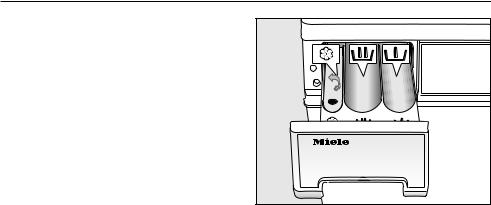
How to wash correctly
E Add detergent
Take the level of soiling and water hardness into account. It is important to dispense the correct amount, because
too little detergent results in:
–Laundry not getting properly clean and with time it may become grey and hard to the touch.
–Greasy particles clinging to the laundry.
–Limescale deposits on the heater elements.
too much detergent results in:
–Excessive foam which causes a low level of agitation and poor wash, rinse and spin results.
–A burden to the environment.
See "Detergent" for further information.
^Pull out the detergent drawer and add detergent to the compartments as follows:
i= Detergent for the pre-wash (1/4 of the total amount recommended). This compartment is also used for starch formulations when starching separately.
j = Detergent for the main wash
§= Fabric conditioner or liquid starch
^ Close the detergent drawer.
17
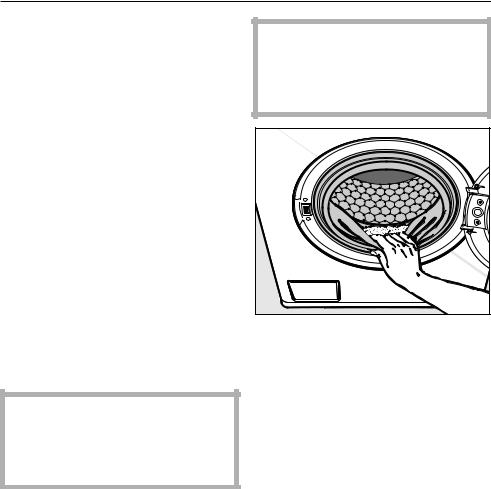
How to wash correctly
F Start the programme
The Start button will flash as soon as a programme can be started.
^ Press the Start button.
The Start button will light up.
The estimated programme duration will appear in the display. This will count down in one minute steps. During the first 10 minutes the machine measures how much water is being absorbed by the laundry. The programme duration may be shorter depending on this absorbency rate.
The programme sequence is also shown in the display. The washer-extractor shows you when each section of the programme is reached.
The drum lighting switches off once the programme has started.
G Remove the laundry
Only remove laundry from the machine once the drum has stopped turning. Reaching into a moving drum is extremely dangerous and could result in injury.
If laundry is not removed immediately the programme has finished, the anti-crease phase will begin and the drum will turn at intervals to help prevent creasing.
Anti-crease will flash alternately with Finish in the display to indicate that the programme has finished.
^Press the a button to open the drum door.
^Remove the laundry.
Check that all items have been removed from the drum. Items left in the drum could discolour other items in the next wash or become discoloured themselves.
^Check the folds in the door seal for any small articles, e.g. buttons which might be lodged there.
^Close the drum door. Otherwise there is the danger of objects being placed inadvertently in the drum. If these remained unnoticed and were washed in the next load, they could damage the laundry.
18

Spinning
Final spin speed
The maximum final spin speed is determined by the individual programme and cannot be changed. See chart.
Programme |
rpm |
|
|
Sluice High |
1400 |
Sluice Low |
1400 |
|
|
Cottons Hygiene |
1400 |
Cottons Uni. |
1400 |
|
|
Minimum iron |
1000 |
Denim |
900 |
|
|
Delicates |
600 |
Quick wash* |
1400 |
|
|
Woollens |
1200 |
Kitchen linen* |
1400 |
|
|
Table linen* |
1200 |
Curtains* |
400 |
|
|
Pillows* |
1400 |
Outerwear* |
900 |
|
|
Proofing* |
800 |
Spin |
1400 |
|
|
* = These programmes are only available if they have been activated via the Settings/Supervisor level.
Rinse and interim spin
There is a spin after the main wash and between the rinses. You cannot alter this spin speed either.
19

Programme chart
Sluice High or Sluice Low* |
Max. load 4.0 kg |
|
|
|
|
Fabric type |
Heavily soiled linen and cottons or cotton mix fabrics, including |
|
|
nappies. |
|
|
|
|
Note |
Two pre-rinses are carried out at the beginning of this |
|
|
programme for removing coarse soiling. |
|
|
|
|
Detergent |
Powder detergent, detergent for coloured fabrics, liquid |
|
|
detergent, tablet detergent and liquid tab detergent. |
|
|
|
|
Cottons Hygiene 95°C 9 |
Max. load 6.5 kg |
|
Fabric type |
Cottons, linens or cotton mix fabrics. |
|
|
|
|
Extra option |
Pre-wash |
|
|
|
|
Detergent |
Powder detergent, detergent for coloured fabrics, liquid |
|
|
detergent, tablet detergent and liquid tab detergent. |
|
|
|
|
Cottons Uni. 40°C, 60°C 78 |
Max. load 6.5 kg |
|
Fabric type |
Cottons or cotton mix fabrics, e.g. T-shirts, trousers. |
|
|
|
|
Note |
– For dark coloured fabrics use a detergent for coloured fabrics, |
|
|
or liquid detergent. |
|
|
|
|
Extra option |
Pre-wash |
|
|
|
|
Detergent |
Powder detergent, detergent for coloured fabrics, liquid |
|
|
detergent, tablet detergent and liquid tab detergent. |
|
|
|
|
Minimum iron 30°C, 40°C, 60°C 678124 |
Max. load 3.5 kg |
|
Fabric type |
Synthetics, mixed fibres and easy care cottons. |
|
|
|
|
Extra option |
Pre-wash |
|
|
|
|
Detergent |
Powder detergent, detergent for coloured fabrics, liquid |
|
|
detergent, detergent for delicates, tablet detergent and liquid tab |
|
|
detergent. |
|
|
|
|
Denim 40°C |
|
Max. load 3.5 kg |
|
|
|
Note |
– Wash denim inside out. |
|
|
– Denim often contains excess dye and will run during the first |
|
|
few washes. Wash light and dark coloured items separately. |
|
|
|
|
Detergent |
Liquid detergent for coloured fabrics. |
|
|
|
|
* The Sluice programmes meet the requirements of the Care Standards Act
2000 Minimum Laundry Standards (Standard 26) and the NHS Executive Health Service Guideline HSG (95) 18.
20

|
|
Programme chart |
|
|
|
|
|
|
Delicates 30°C 1c |
Max. load 2.5 kg |
|
|
|
|
Fabric type |
For delicate garments made of synthetic fibres, mixed fibres, |
|
|
rayon and easy care cottons. |
|
|
|
|
Extra option |
Pre-wash |
|
|
|
|
Detergent |
Liquid detergent for delicates. |
|
|
|
|
Woollens / 30°C c |
Max. load 2.5 kg |
|
|
|
|
Fabric type |
Machine-washable or hand-washable wool or wool blend fabrics. |
|
|
|
|
Detergent |
Liquid detergent for machine-washable woollens. |
|
|
|
|
Drain |
|
|
|
|
|
For draining water from the machine. |
|
|
|
|
|
Spin |
|
Max. load 6.5 kg |
|
|
|
For spinning garments. Please make sure you select the appropriate spin speed.
21
